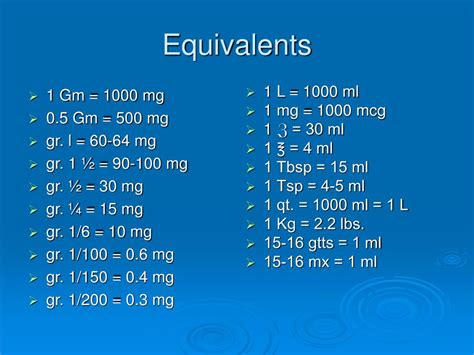The question of how many milliliters (mL) are in a milligram (mg) is a common point of confusion, largely due to the fact that milliliters and milligrams measure different physical quantities. Milliliters are a unit of volume, typically used to measure liquids, whereas milligrams are a unit of mass or weight. Because of this fundamental difference, there is no direct conversion between milliliters and milligrams without knowing the density of the substance being measured.
Understanding Density

Density is defined as mass per unit volume. It’s expressed in units such as grams per milliliter (g/mL) or kilograms per liter (kg/L). Knowing the density of a substance allows you to calculate the volume (in mL) of a given mass (in mg) of that substance. The formula for this calculation is: Volume (mL) = Mass (mg) / Density (mg/mL).
Conversion Example
For instance, if we want to find out how many milliliters of water are equivalent to 1000 milligrams (or 1 gram, since 1 gram = 1000 milligrams), we would use the density of water. The density of pure water is approximately 1 gram per milliliter (g/mL) at standard temperature and pressure. Thus, for 1000 milligrams (1 gram) of water, the volume would be 1 gram / 1 g/mL = 1 mL.
| Substance | Density (g/mL) | Volume of 1000 mg (mL) |
|---|---|---|
| Water | 1 | 1 |
| Air (at standard conditions) | Approximately 0.0012 | Approximately 833.33 |
| Mercury | 13.546 | Approximately 0.0739 |

Practical Applications

In practical scenarios, such as pharmacy, cooking, or chemistry, understanding how to convert between mass and volume is essential. For instance, when preparing a solution, knowing the volume of a solvent needed for a specific mass of solute is critical for achieving the desired concentration.
Key Points
- Milliliters (mL) measure volume, while milligrams (mg) measure mass.
- The conversion between mL and mg requires knowledge of the substance's density.
- Density is mass per unit volume, expressed in units like g/mL.
- The formula for conversion is Volume (mL) = Mass (mg) / Density (mg/mL).
- For water, 1000 mg (1 gram) equals 1 mL because its density is approximately 1 g/mL.
In conclusion, while milliliters and milligrams are fundamentally different units, knowing the density of a substance allows for precise conversions between them. This understanding is vital in various fields, from science and medicine to cooking and engineering, where accurate measurements are crucial for desired outcomes.
What is the primary factor determining the conversion between milligrams and milliliters?
+The primary factor is the density of the substance being measured. Density is mass per unit volume and is crucial for converting between units of mass (like milligrams) and units of volume (like milliliters).
Can you provide an example of how density affects the conversion?
+Yes, for example, 1000 milligrams of water and 1000 milligrams of mercury will have vastly different volumes due to their different densities. Water has a density of approximately 1 g/mL, meaning 1000 mg (1 gram) of water is equivalent to 1 mL. Mercury, with a much higher density (about 13.546 g/mL), means that 1000 mg of mercury would be equivalent to a much smaller volume, approximately 0.0739 mL.

